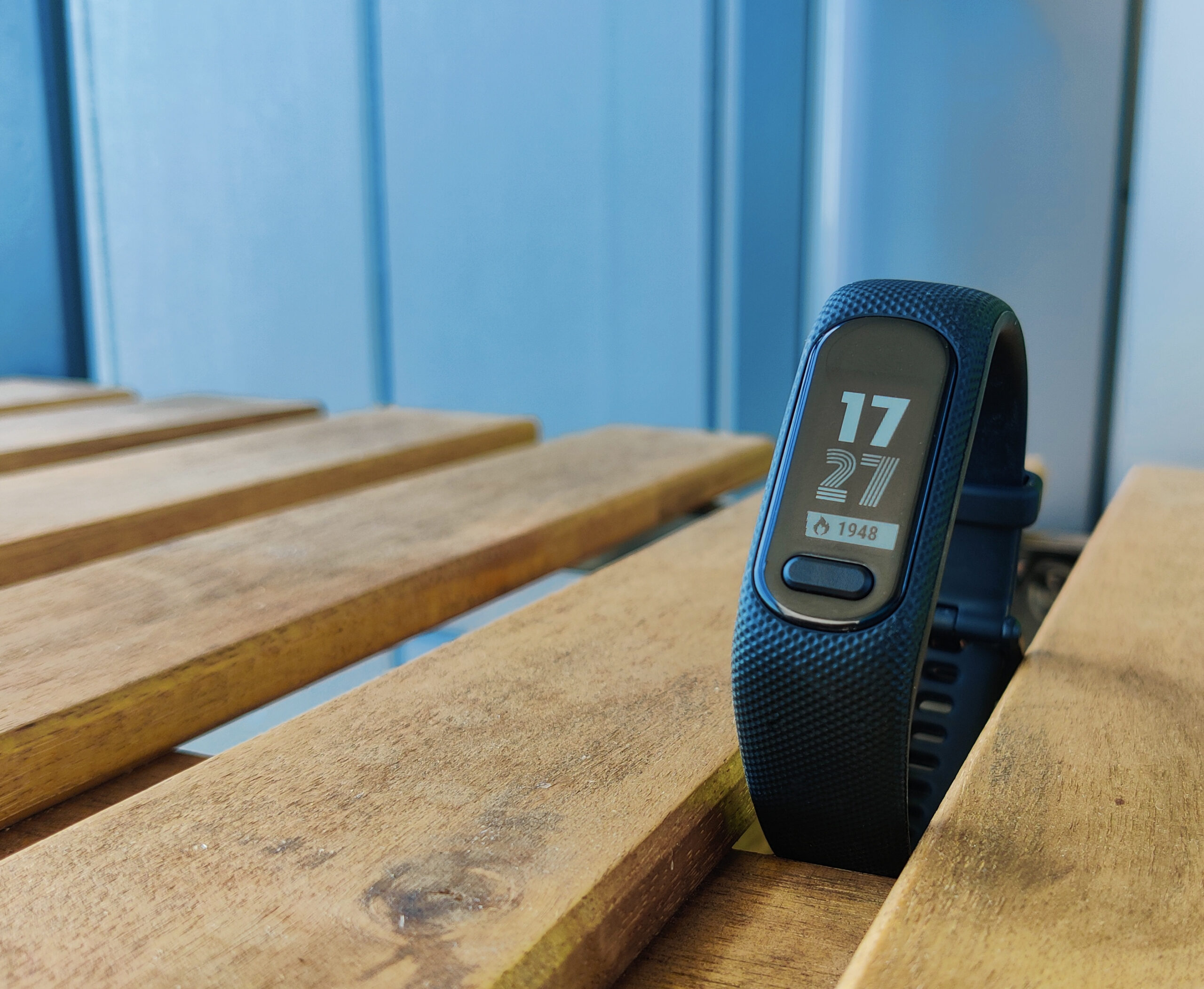Smartwatches are extremely helpful tools to track our activity, help us stay more connected and add convenience to our lives. They are, however, not for everyone. For some they are too bulky, for others too expensive, and for some people there is little positive about “staying connected”. This is where fitness trackers come in – smaller, cheaper armbands dedicated to tracking your sports activity, with a few but not that many extra features on top.
The Garmin Vivosmart 5 is the top-of-the-range fitness tracker by Garmin, one of the leading brands in this space. As the name suggests, it is now in its fifth generation, so one might be hopeful that by now Garmin have learned a thing or two about building great fitness trackers.
In this review I look at the Garmin Vivosmart 5 primarily from a strength training perspective, although I also touch on general lifestyle usage.
But first, because the Internet is broken, I’ll write the same thing in a couple of different ways so that people can find this article, which covers:
- Garmin Vivosmart 5 Strength Training Review
- Garmin Vivosmart 5 Weightlifting Review
- Garmin Vivosmart 5 Resistance Training Review
- Garmin Vivosmart 5 Review for Gym
- Garmin Vivosmart 5 Bodybuilding Review
- Garmin Vivosmart 5 Powerlifting Review
I think that’ll do.
Get the Garmin Vivosmart 5: Amazon US | Amazon UK
Note: Buying via the links above give a small commission to me at no extra cost to you.
Good
- Fairly unobtrusive
- 5-7 day battery life
- Rest period tracking in workouts very useful
- Changing straps is super easy
Bad
- Physical button unreliable
- Screen not the most responsive, leading to some frustrating scenarios
- No on-device exercise weight tracking
- Exercise detection so-so
- Competition has extra features like payments
Table of Contents
- Design and Build
- Display and User Interface
- Health & Fitness Tracking
- Strength Training
- Sensor accuracy
- Music
- Sleep
- Smart features
- Battery
- Pricing
- Verdict
Design and Build
The Garmin Vivosmart 5 is a pretty small wristband, at least compared to most smartwatches. It consists of the tracker itself – a pebble made out of plastic and acrylic – and a silicone strap which houses the tracker. This separation is a welcome feature, as the silicone straps are often the weakest link in the durability of a wearable so it should be easily replaceable.
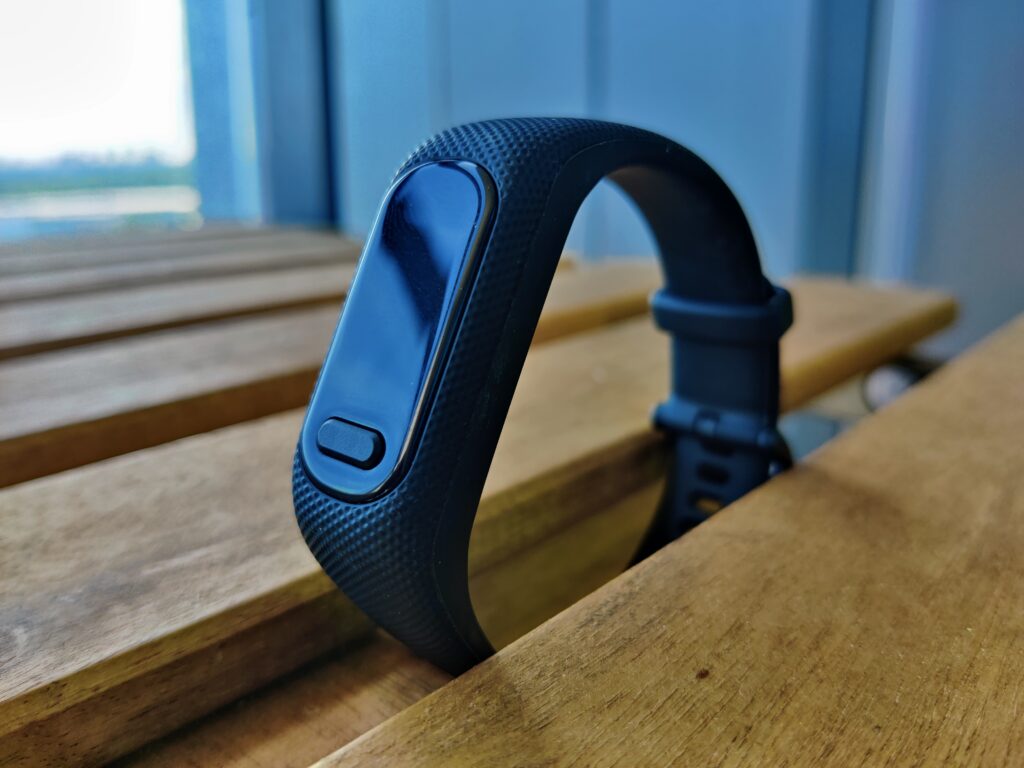
The original strap comes in two sizes: “small/medium” and “large”. In both sizes the tracker itself is identical, the only difference is in the strap. I’m used to being on the L/XL end for most products I use, so I ordered the large strap. However, I actually wear it close to the tightest configuration, so probably the medium size would have been a better fit. That is to say, make sure to measure your wrist and order the size that’s best for you (the S/M model fits 122-188 mm wrists, whereas the L model fits 148-228 mm).
The smaller strap comes in black, white and “cool mint”, which at least gives you a bit of a choice in color (the large strap is black only). Thanks to the tracker-strap separation though you can get a bunch of more fun colours from third party sellers, such as these ones.
The tracker has a single physical button at the bottom of the screen, and you navigate most of the user interface using the 10 by 18 mm touchscreen. The button itself is pretty clicky but sometimes seems to only press halfway and not trigger despite giving a click feedback.
All in all the Vivosmart 5 looks like any other tracker, which is to say it does not stand out, for better or for worse.
Display and User Interface
The display is a 10 by 18 mm black-and-white OLED screen. It is not particularly vibrant or sharp, but it only has to show limited amount of information and it very much gets the job done, so I have no issues with it.
The touch interface is a slightly different story. It is functional but not very responsive, which is to say that it registers touches and swipes most of the time but not always, and there’s a bit of lag between your action and something happening on the screen. Now again, it gets the job done, but the slow speed and occasional misses have annoyed me a few times when I’m trying to do something and the UX gets in my way.
Much like other Garmin wearables, the Vivosmart 5 organises information in “widgets”. In true Garmin fashion, these are slightly different from widgets on all other Garmin’s devices. On the Vivosmart 5 they are very simple, showing you the basic numbers without any options to dig deeper or look at any graphs. You can access widgets by swiping up/down from the home screen.
By pressing the physical button you open the menu, from where you can start activities, set timers, and adjust some settings.
Finally, swiping right gives you access to quick controls like toggling Do Not Disturb mode and finding your phone by triggering a loud signal on it. The latter is a killer feature that I use pretty much daily.
Health & Fitness Tracking
The Garmin Vivosmart 5 tracks a number of metrics during the day & night using the onboard sensors.
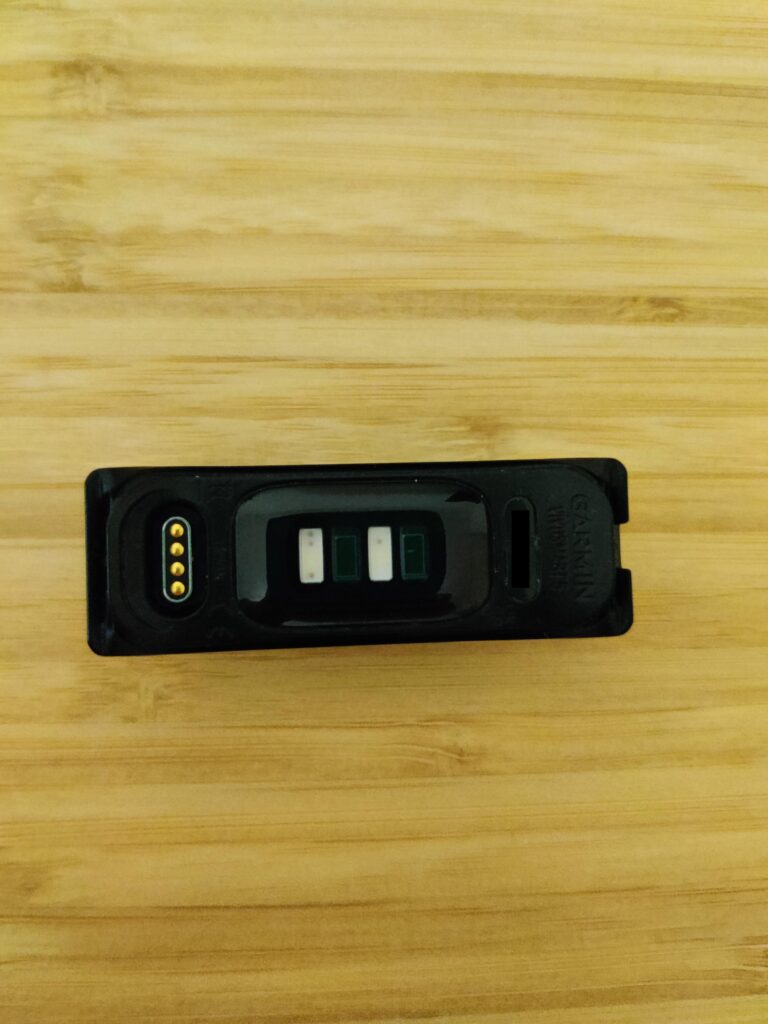
Steps are tracked and reported on for each day, and it’s easy to see how far along in your target you are at any point. You can choose to set a fixed daily step goal, or use “Auto Average”, which basically means that Garmin will automatically set a goal each day based on previous couple of days.
Heart rate is measured continuously and saved in the Garmin Connect app. Blood oxygen saturation (PulseOx) is measured on demand or a few times a night if you enable that option. Note that doing this will eat into your battery life.
On top of these direct sensor measurements, Garmin provides a few higher level metrics. These include weekly intensity minutes, calories burned, and “body battery”, which is an estimate of how much energy you have for physical activity.
The intensity minutes is a measure of how much time your heart has spent beating fast. It’s a bit more complicated than that, as you get different multipliers for different HR zones, but that’s the gist. I personally find this metric the most useful. It is clearly an approximate value, but gives a quick gauge of how active I’ve been this week and pushes me to move when the number is lower than I’d like.
Rather surprisingly, the Vivosmart 5 does not track floors climbed. This is a bit of a disappointment as most other Gamin devices do this, including the previous generation Vivosmart 4. I find floors climbed to be quite helpful as a nudge to take the stairs, so it’s a real shame Garmin have axed it here.
Activity profiles
The Vivosmart 5 comes with 14 activity profiles built in. On the Connect app, you can configure which profiles are available for selection on the tracker itself.
I generally find the selection okay for basic activity tracking. If there’s an activity you’d like to track that’s not there (e.g. Water Polo), you can pick the catch-all “Other” profile and rename the activity afterwards in the Garmin Connect app.
Activity Auto-start
The walk and run activities can be auto-tracked (an optional feature). This means the tracker can start an activity by detecting a regular movement pattern, and auto-stop and save the workout once you stop. If your phone’s location is enabled, it will also be tracked throughout your walk or run.
In my time with the Vivosmart 5, this feature was pretty reliable: there was only one occasion where I walked for half an hour and the tracker did not start a walk at any point.
The auto start can be quite convenient if you want to look at your walk summary later on, but comes with the downside of consuming your phone’s battery life (via connected GPS). In addition, there are privacy implications of Garmin knowing where you are every time you take a walk, even if you haven’t explicitly chosen to track an activity.
Strength Training
There is a dedicated Strength Training profile on the Garmin Vivosmart 5. Depending on the settings you tweak however, your in-workout experience can vary quite a bit.
The chief two toggles you can adjust are Rep Counting and Auto Sets, resulting in 3 distinct in-workout experiences.
Workout without rep counting
In this mode, you simply start a workout, do your thing, and then stop the workout. During the session you’ll be able to see the elapsed time and your heart rate, and that’s pretty much it.
When you finish a workout, it’ll appear on your Garmin Connect app as a basic strength activity, showing time, heart rate, and calories burned. At this point you can also add any exercises, sets, reps & weights you did if you feel like it.
This is a good profile to use if you’re tracking your reps & sets somewhere else and pretty much just use the Vivosmart 5 for heart rate tracking & general workout calendar logging.
Workout with rep counting
If you enable the rep counting feature, the workout is structured as a series of active sets and rest periods. The Vivosmart 5 will auto-count your reps, and after every set (you have to mark set start and finish manually) you can see this count and adjust it if it’s off. Between sets, the tracker shows your rest time so far.
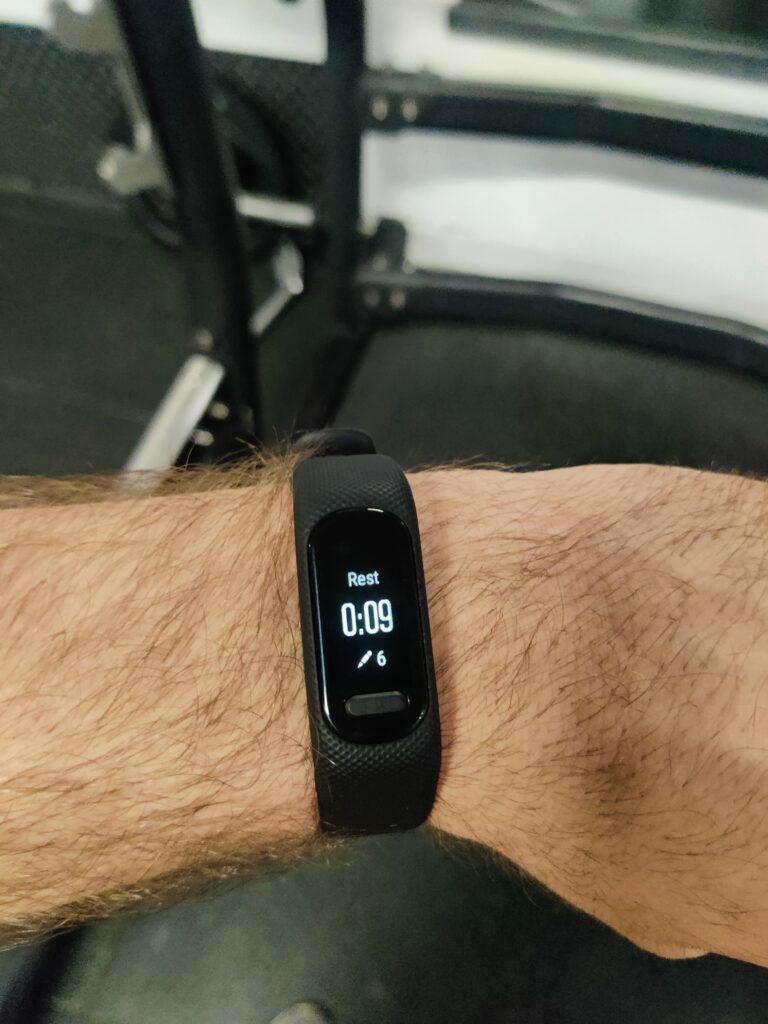
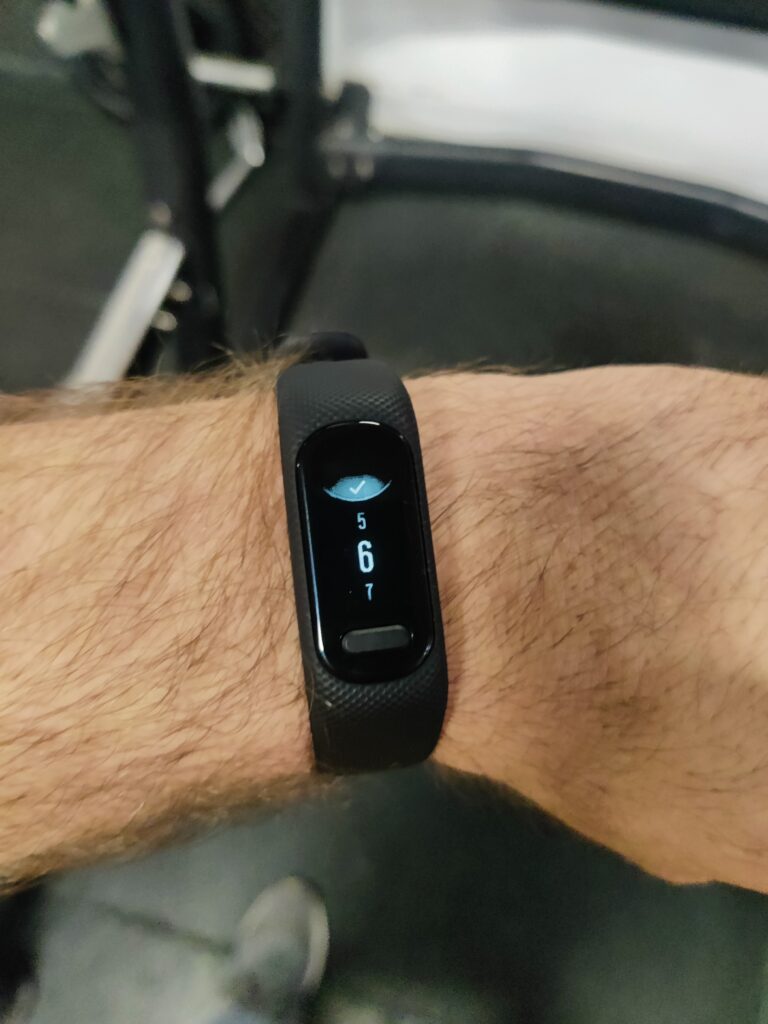
The rep counting is mostly pretty decent, but it is not very consistent, and clearly depends on the exercise. For any large, periodic movement pattern like a bench press or a squat it is usually within 1-2 reps of the real value. For more complicated or uncommon movements this can be off by substantially more than that. However, every now and then the Vivosmart 5 seems to not “lock on” and gives me some ridiculously low number like 1 or 2 when I’ve done anywhere from 8 to 20 reps. This has happened for all types of exercises.
The rest time feature is genuinely helpful, as it helps keep me on track and I don’t need to use my phone or any other device for that, which would be further away than my wrist and therefore less convenient.
Once you’re done with the workout, it will show up on Garmin Connect with all of the sets & reps you logged. For each set, the Vivosmart 5 will have guessed the exercise based on the movement pattern. At this point you can correct any errors and enter exercise weights. Based on the guessed exercises, the app also shows you a muscle map highlighting the muscle groups that got some love in this session.


Whether this system works well for you will obviously depend on your workout routine, tracking style etc, but I personally find it quite limiting. In particular:
- The automatic exercise detection is not very good, which means you have to do a lot of corrections if you want to keep track of your workouts in the Garmin Connect app (which is kinda the point).
I generally found that some very common exercises like a bench press are recognised pretty much every time, and exercises with a similar movement pattern to bench press (like overhead barbell press) are consistently classified as bench press too. A number of other exercises like squats, pull-ups, and lateral raises are correctly classified most of the time but not always, and then the less common ones are usually just left as unknown. - When you correct a misclassified exercise, you can only choose from a list of exercises maintained by Garmin. On one hand, I can see why Garmin chose to do this: it helps to control the quality of data in the app and enables features such as the muscle map. However, the way it is currently implemented has a couple of serious shortcomings:
- Even though the set of available exercises is large (Garmin claims it is 1400+), there are still quite a few less popular exercises (or ones you make up!) that are not available. For example, yesterday I did some sets of machine rear delt flies, which was not present in the list. I replaced it with Incline Reverse Fly, which is close enough but muddies the waters. An option to extend the set with custom exercises (even if they have to be approved by Garmin) would be very welcome.
- The 1400 number above should be taken with a pinch of salt due to the quality of the data. For example, searching the set for “squat” returns 120 results, which includes some genuinely useful variations like Sumo Squat, Jump Squat, and Goblet Squat, but also all of the following: Squat, Back Squat, Weighted Squat, Barbell Back Squat, Weighted Back Squat, Back Squat with Body Bar. How exactly they are different is anyone’s guess.
- You have to correct every set individually, which can get very repetitive. Some bulk editing would be quite useful.
- The fact that you cannot enter the weights of each set on the tracker itself means you need to keep that log somewhere else (which could be just memory).
I personally found that if I updated the values in the app immediately after the workout I could remember all weights surprisingly well. However, life inevitably gets in the way, and if I didn’t have the time to make corrections immediately my memory started to degrade very quickly. - The lack of responsiveness in the UX can sometimes get in the way. Two examples I’ve noticed in particular:
- The physical button, which is used to mark the start and end of a set, sometimes seems to click “half-way” only. By that I mean that it gives off a clicky noise and feel but doesn’t actually register. This can lead to missing sets if you don’t look at the screen to confirm that the set has actually been started.
In addition, the rep edit touch button is right above the physical one, so sometimes not only does the set not start but you’re thrown into the rep edit section.
- When you’re editing reps, you have to scroll up and down on a vertical list. However the screen is not very responsive so I found myself constantly over- or undershooting the actual rep value. This is not a dealbreaker as you can instantly correct it but it is quite annoying.
- The physical button, which is used to mark the start and end of a set, sometimes seems to click “half-way” only. By that I mean that it gives off a clicky noise and feel but doesn’t actually register. This can lead to missing sets if you don’t look at the screen to confirm that the set has actually been started.
I’ll also note that the whole exercise selection feature lacks polish in a couple of places. For example, depending on various factors a bodyweight exercise may show up as “Body”, “0.0” or “–” as in the example below. It’s not a dealbreaker but is just a little jarring and reduces my trust in the app.
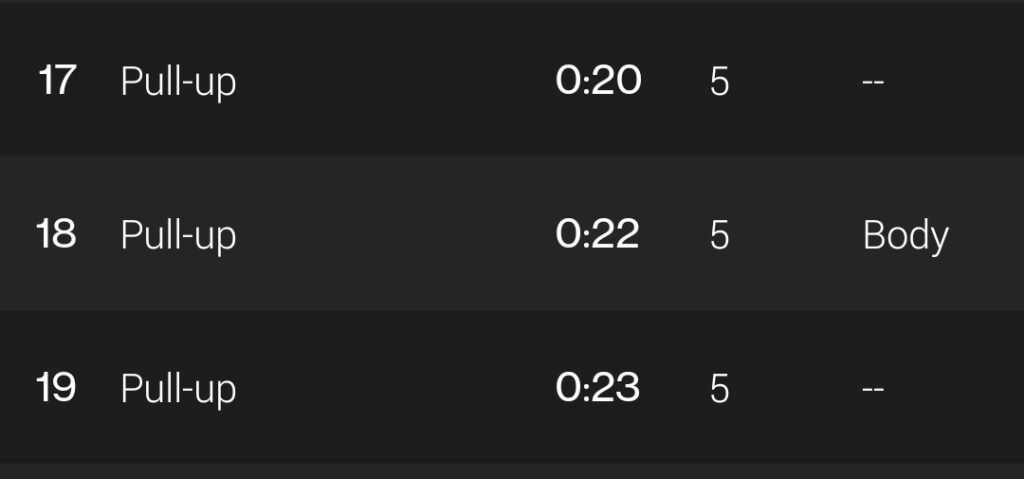
Workout with rep counting and auto sets
With the Auto-set toggle enabled in the settings, the Vivosmart 5 should not only count your reps in every set, but also automatically start and stop sets as it identifies periodic movement patterns. Emphasis on should.
I tried to do a workout with auto-set enabled many times, but never managed to get it to work. I tried enabling it on the watch, in the Connect app, disabling and enabling, and resetting the watch. Whatever I did, the workout always behaved just as it does without auto-set, i.e. it prompted me to press the physical button to start and end sets.
I don’t know if this is an issue with my unit in particular, although that would be a very bizarre defect. I suspect it’s a bug that hasn’t got Garmin’s attention yet because not enough people have complained about it.
On the bright side, Garmin is usually very good at issuing software updates to their wearables so I’d expect this to be patched up at some point. However, the auto-set feature on their other devices, such as the Venu 2, does not work very well so I wouldn’t expect much from it.
Sensor accuracy
Heart Rate
I’ve worn the Vivosmart 5 alongside a chest strap to a quite a lot of workouts, and I think I’ve seen the main trends in its heart rate reading behaviour.
The first observation is that it struggles to keep up with rapid heart rate increases. In most intense sets it misses the HR peak entirely, and then slightly overshoots after the set as it realises that something changed. See the plots below of two workouts.
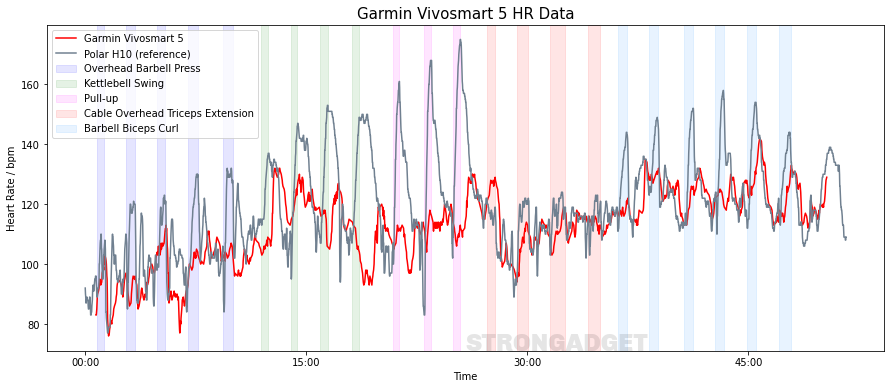
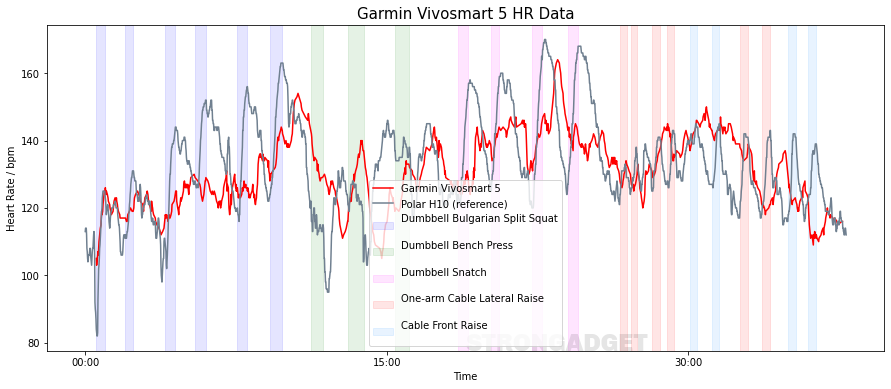
For cases where the HR peaks are more sustained (e.g. cardio) this might just result in a slight delay that’s acceptable, but it works pretty poorly for tracking strength training.
The second point to note is that HR tracking quality didn’t seem to depend all that much on the exercise. In all sets I did, whether it was back squats, lateral raises or dumbbell snatches, the tracking was more accurate at lower intensity and failed to increase quickly enough when intensity grew.
Smartwatch HR tracking often does worse in exercises with more wrist movement, and I was expecting similar behaviour here. I suspect that it’s not happening because the tracker is lightweight enough that normal wrist movement during the day pushes it slightly up your arm where it sits at a more stable position. Whether this looks good or bad depends on your taste, but it does seem to help with heart rate tracking.
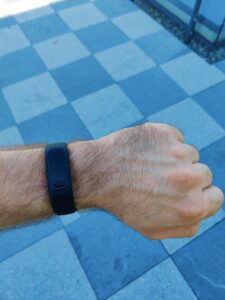
Overall, any Vivosmart 5 HR data from strength training activities should be taken with a hearty grain of salt. If you’re interested in HR data for cardio health or calorie tracking purposes, this tracker is probably not for you.
GPS
The Vivosmart 5 does not have built-in GPS. Instead, it uses your phone’s GPS signal if your phone is nearby and has location enabled. This means that the accuracy will be as good as your phone can provide. I also means that you have to take your phone with you anytime you want to track your GPS for a walk, run, bike ride etc.
Music
The Vivosmart 5 does not have any onboard storage for music. However, it can control the music (or any audio content) playback on your phone. This control is fairly basic and comes with a few quirks.
The first quirk is the setup. In order to control music outside of a workout, you need to enable the Music widget via the Garmin Connect app. When you’re in a workout however, this widget is not accessible without ending the workout first. To control music during a workout, you have to edit each activity profile you want in the Garmin Connect app and add a Music “data screen”, which can then be accessed by swiping up/down on the tracker.
The music interface offers only three functions: play/pause, switch to next track, switch to previous track. This is alright for most music scenarios but can be a little limiting for podcasts, which is my preferred gym noise.
Switching tracks is also a little quirky: you switch to next track by swiping left-to-right, and previous by swiping right-to-left. This is opposite to most touch screen music interfaces, and I found it a bit jarring & confusing. I’m sure it’s easy to get used to but it’s just a funny decision worth mentioning.
The main problem here is, yet again, responsiveness. Because of unreliable touch detection and lag in the response, I was never quite sure what to expect when I was controlling audio. After a few instances of play/pause tap not registering, and unintentionally skipped podcast episodes, I decided to go without the built-in music controls.
Sleep
Like most other trackers and smartwatches, the Garmin Vivosmart 5 tracks your sleep at night.
I generally found that it was very accurate at identifying bedtime and wake time. It also provides information on various sleep stages, which I won’t pretend to know much about.
I find sleep tracking useful for two scenarios. Firstly, it’s seeing the sleep trends over a the last couple of days (or even longer). This is very easy to see in the Garmin Connect app, see an example below.
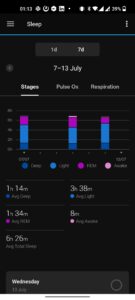
Secondly, I find that sometimes I’ve had pretty poor sleep but don’t quite yet feel that when I wake up. I might then decide to do something stupid like going for a workout or cycling to wherever I need to be instead of choosing a less demanding mode of transportation. If the Vivosmart tells me I’ve slept badly, it’s usually right and it nudges me to take it easy.
Smart features
Although it is a tracker, not a fully fledged smartwatch, the Vivosmart 5 actually offers some “smart” features. These include notifications from your phone and weather on your wrist. If you have an Android phone, you can even respond to texts (or WhatsApp messages etc) directly from your wrist with canned responses.
While these are nice features to have on paper, in practice I didn’t get much use out of them at all. This is mostly because the screen is so small and narrow that no text really fits on it. To get around this, the tracker scrolls the text horizontally until it’s all been displayed, but that kind of defeats the purpose of having notifications on your wrist that you can read at a quick glance.
The only scenario where I found the notifications helpful was when I got a call and my phone was in the other room with sound turned off. Thanks to the Vivosmart I didn’t miss the call.
Unlike some competitors, this tracker does not offer any wrist-based payments, which is a bit of a bummer.
Battery
Garmin advertises up to 7 days of battery life, and frankly I think that’s a reasonable estimate. If you enable regular PulseOx this will bring this number down to more like 3-4 days.
I usually track a couple of workouts a week, enable walk auto-starting which adds a few more activities, and keep PulseOx disabled. This gives me about 6 days of battery life, which is pretty darn good for what it does in my book.
Pricing
At the time of writing the Vivosmart 5 costs $149.99 / €149,99 / £129.99. This is sort of in the ballpark of other higher end trackers, and pretty cheap compared to most smartwatches.
You can check out the latest pricing by clicking the links: Amazon US | Amazon UK
Verdict
The Garmin Vivosmart 5 is a pretty solid everyday tracker, and can give you the right ballpark estimate for how much physical activity & sleep you’re getting in any given day or week. If you’re looking for something simple that looks neutral, runs for days on a charge and doesn’t cost ridiculous amounts of money, the Vivosmart 5 is a good option with a strong ecosystem and good reputation for software and customer support.
That said, it is a fairly limited offering. Its responsiveness in particular is an issue, often making the interactions cumbersome and annoying. The strength tracking profile is nice to have for tracking rest time and overall workout frequency, but the absence of weight tracking during workouts and subpar exercise detection means there’s too much friction to use it regularly. The HR sensor falls apart when intensity increases rapidly, and it does not offer some convenient features like wrist based payments that direct competitors have introduced.
I will update this post with alternatives as they come in and I get a chance to review them properly.
Stay strong,
Ansis
